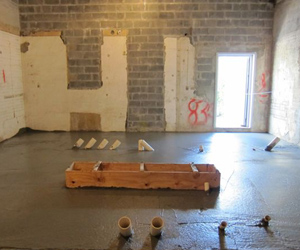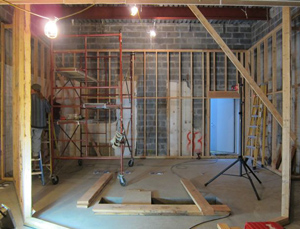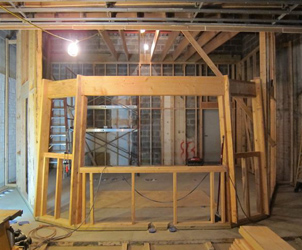Marc Alan Goodman’s Building Strange Weather Blog: A Control Room is Born
Latest in the “Building Strange Weather Blog” series by producer/engineer and studio owner Marc Alan Goodman. Click to start at Step 1: Finding A New Home; #2: Design; #3: Waiting For Permits (Part 1) and #4: (Part 2); and #5: Stops & Starts, #6: Demolition, #7: The Structural Work, #8 The Joys of Home Ownership, and #9 Rain, Rain, Rain.
Wow, what a month. If you remember last time we were held up because of rain, and I was watching it fall through and collect in our basement, wondering when we would get an opportunity to seal up the roofs. That opportunity finally came, and inside work has seriously begun. But first came AES.
In no way could I have expected the outpouring of support for the build we received during the convention. It seemed like every person we spoke to had heard about the build and had great things to say about how excited they are to see the place finished. After a year of toiling with what has felt like minimal results my ego got the boost it needed, and the excitement has returned. I’d like to take a quick moment to thank all of you reading this. Just knowing you’re doing that is moving this project along more than anything else.
Getting back to business, the Tuesday following the Convention Tony Brett and his crew came up from North Carolina to frame the control room. I don’t think I’ve ever met a better crew of guys in my life. To call them craftsmen feels like an understatement.
First thing on Tuesday they walk into the space and immediately discover everything I’ve been doing wrong, but in a very constructive way. One look at the few existing HVAC problems and Tony was able to tell me exactly what I needed to change to make it work.
At some point our engineer had switched out the split units (where the compressor is outside and the air handler is inside) for combined units that are entirely outside. While this does put the fan in the air handler farther away from the actual control room, it also means that there’s nothing isolating the ducts on the outside from the ducts on the inside; hence, mechanical noise such as rainfall could become a serious problem.
The solution is relatively simple in that we need to insulate the ducts that are outside in some way, but without that knowledge now we could have had a serious problem on our hands further down the road.

Fresh concrete on the control room floor, with PVC pipes running underneath. The wood box will be the cable trough for underneath the console.
After analyzing the mechanical plans further, I am now going back to my engineer to redraw the entire thing. If we had installed the rest of the HVAC to the current plans it would have all had to be torn out. In an hour Tony had saved me more money than it was costing to put them up in a Brooklyn hotel for the month of work they’ll be doing.
The next big discovery was the centerline of the building. We had already laid out PVC piping for the studio wiring under the control room floor. The floor is cement and we had poured a new layer on top of it.
But when we measured the room to figure out where to place the pipes, which need to come up exactly under the console, racks, and patchbay, we worked from the center of the back wall. It turns out that the rear section of the building, which was built after the front, skews away at a slight angle. It’s only a difference of two or three inches, but suddenly it was clear that not having a definitive centerline to work from would have a severe effect on the symmetry of the place.
Out came the laser levels and scientific calculator, and a few tough measurements and trigonometric functions later, Tony had discovered a centerline that could be followed through the entire building without having to change the plans in any way. And then, the real work began.
The framing of the control room itself seemed to happen in a flash. The guys knew exactly what they were doing, and weren’t afraid to go back and recut a piece of wood seven or eight times in order to get the exact angle needed to make the room fit together. If I had to guess I’d say that they were working well within a sixteenth of an inch tolerance, and doing so with ten-foot pieces of lumber from a New York yard, some of which were straight and some not so much.
The front corners of the room were most perplexing to me, where multiple angles on multiple planes intersect, but Tony and his crew didn’t even flinch. By mid-Sunday afternoon the control room was standing as it’s going to stand from now on, and it finally looks like we’re building a recording studio.
On top of all of that, the guys helped me identify a number of problems I need to deal with including leaks, plumbing and electrical issues, and dozens of other things. I thought that being a year into this project, I had a pretty complete understanding of the plans, but suddenly it was like I was looking at a whole new set.
I have my work cut out for me over the next few weeks getting everything in line for them to come back up and help finish the framing, but for the first time I feel like I know exactly what it is I need to be doing.
Other parts of the project are coming along as well. In the apartment, all of the walls are framed, the plumbing is roughed in and the electric is all in place. Next step is to get an inspector to sign off so we can sheetrock the walls. However the riser diagrams on our stamped plans are missing one HVAC unit and a boiler, which means we need to get the plans changed before we can move on, and as I’m sure you know now, getting the Department of Buildings to do anything is a nightmare. Hopefully we’ll have all of that lined up just in time to sheetrock the studio as well.
Oh, and my neighbor who’d disappeared after demanding that I remove a tree finally sent a check, which at this point I had all but given up on receiving. Things are looking up and up.
You can head over to our photoblog at http://strangeweatherbrooklyn.blogspot.com if you want to see more pictures of the control room framing process, and as always please feel free to contact me if you have any questions at all.
And thanks for reading!
– Marc Alan Goodman
strangeweathersound [at] gmail dot com
http://strangeweatherbrooklyn.com
Marc Alan Goodman is a producer/engineer who’s worked with artists such as Jolie Holland, Marc Ribot Shudder to Think, Dub Trio, Normal Love, Alfonso Velez, Angel Deradoorian and Pink Skull.
Please note: When you buy products through links on this page, we may earn an affiliate commission.









Matt McCorkle
November 10, 2011 at 6:37 am (12 years ago)Go Marc!!
Theo
November 18, 2011 at 5:26 pm (12 years ago)woot woot!